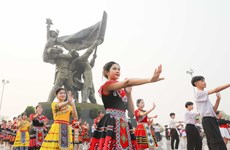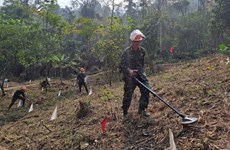Project promotes heritage tree preservation
A programme to preserve Vietnam’s rare trees, which was launched in
March 2010 by t he Association for the Conservation of Nature and
Environment (VACNE), has received a fervent response in many
localities.
A programme to preserve Vietnam’s rare trees, which was launched in
March 2010 by t he Association for the Conservation of Nature and
Environment (VACNE), has received a fervent response in many
localities.
The programme aims to select and honour the country’s heritage trees in a bid to conserve their gene sources, while raising public awareness of protecting the environment.
It also contributes to promoting the diversification and abundance of Vietnam’s flora as well as developing scientific research in the field.
Nearly 500 trees in over 40 provinces and cities have been named Vietnam Heritage Tree so far.
They included especially rare trees like the 2000-year-old teak tree in Viet Tri city, northern Phu Tho province and the 1000-year-old parashrea stellata tree in northern Ninh Binh province’s Cuc Phuong National Park.
According to the VACNE, to be recognised as heritage, the trees must be at least 200 years old in the case of wild trees, and at least 100 years for those planted. Moreover, the trees should be connected with the historical and cultural characteristics of the area where they grow.
Other trees, which do not meet the criteria mentioned above but have special values in science, history or culture, are also honoured as heritage.
Recently, the VACNE recognised 20 mango trees grown at the national historic site of Tu Quang pagoda in the central coastal province of Phu Yen as national heritage trees.-VNA
The programme aims to select and honour the country’s heritage trees in a bid to conserve their gene sources, while raising public awareness of protecting the environment.
It also contributes to promoting the diversification and abundance of Vietnam’s flora as well as developing scientific research in the field.
Nearly 500 trees in over 40 provinces and cities have been named Vietnam Heritage Tree so far.
They included especially rare trees like the 2000-year-old teak tree in Viet Tri city, northern Phu Tho province and the 1000-year-old parashrea stellata tree in northern Ninh Binh province’s Cuc Phuong National Park.
According to the VACNE, to be recognised as heritage, the trees must be at least 200 years old in the case of wild trees, and at least 100 years for those planted. Moreover, the trees should be connected with the historical and cultural characteristics of the area where they grow.
Other trees, which do not meet the criteria mentioned above but have special values in science, history or culture, are also honoured as heritage.
Recently, the VACNE recognised 20 mango trees grown at the national historic site of Tu Quang pagoda in the central coastal province of Phu Yen as national heritage trees.-VNA












